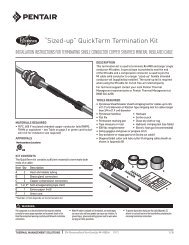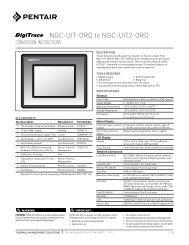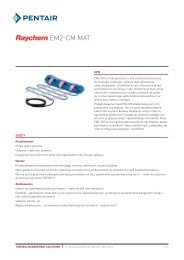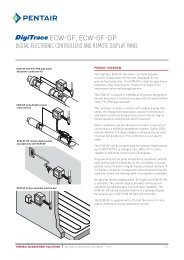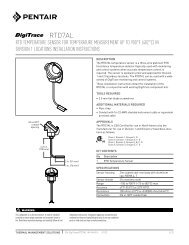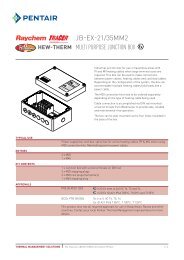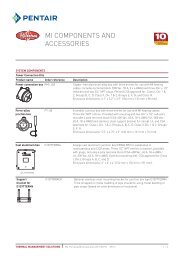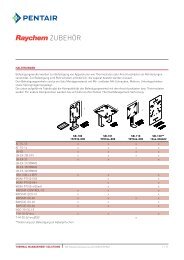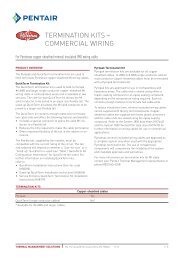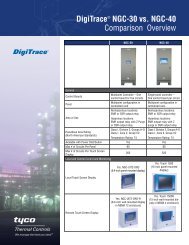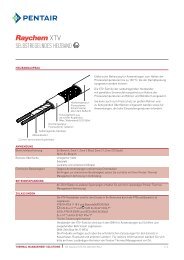TTDM-128 - Pentair Thermal Management
TTDM-128 - Pentair Thermal Management
TTDM-128 - Pentair Thermal Management
- No tags were found...
Create successful ePaper yourself
Turn your PDF publications into a flip-book with our unique Google optimized e-Paper software.
TRACETEK <strong>TTDM</strong>-<strong>128</strong>TraceTek Leak Detection Master Module Installation InstructionsGeneral InfORMATIONPlease read these instructions carefully and keep them in a safeplace (preferably close to the <strong>TTDM</strong>-<strong>128</strong>) for future reference.These instructions must be followed carefully to ensure properoperation.The <strong>TTDM</strong>-<strong>128</strong> Leak Detection Master Module has been designedspecifically for use with TraceTek sensing cables, point sensors,sensor interface modules and relay modules. The <strong>TTDM</strong>-<strong>128</strong> candirectly monitor up to 1500 m (5000 ft) of sensing cable, and largenetworks of remote leak detection modules.An external disconnect device and appropriate branch circuitprotection (no more than 20 amp rating) should be provided forthe <strong>TTDM</strong>-<strong>128</strong>. The disconnect device should be clearly markedas such. Follow all national and local codes and regulationsapplicable to the installation.Approvals AND CERTIFICATIONSTYPE NMGeneral Signaling Equipment76LJTools Required• Drill or hole punch for electrical conduit entries• Phillips (cross-head) screwdriver• Small flat-head screwdriverInstallation Items (NOT supplied)• Wall fasteners for surface mounting (four screws)StorageKeep the module in a dry place prior to installation to avoidpossible damage to internal components.Product InfORMATION<strong>TTDM</strong>-<strong>128</strong>115 Vac +15%, –20%; 50/60 Hz230 Vac ±10%; 50/60 Hz<strong>TTDM</strong>-<strong>128</strong>-24V 24 Vac +5%, –35% 24 Vdc ±20%Power consumption 10 VA for <strong>TTDM</strong>-<strong>128</strong>9 VA for <strong>TTDM</strong>-<strong>128</strong>-24 VInstallation categories Overvoltage Category II, Pollution Degree 2Built-in relays Number: Three (Service, Leak, Fault)Type: DPDTRating: 5 A at 250 Vac/24 VdcStorage temperature –18°C to 60°C (0°F to 140°F)Operating temperature 0°C to 50°C (32°F to 122°F)Enclosure Type 12; IP 54Humidity5% - 95% non-condensingMax Altitude2000 m (6,562 ft)Important Warnings and NotesThe following icons are used extensively throughout this manual to alert you to importantwarnings that affect safety and to important notes that affect the proper operation of theunit. Be sure to read and follow them carefully.THERMAL MANAGEMENT SOLUTIONS EN-TraceTek<strong>TTDM</strong><strong>128</strong>-IM-H57341 09/131 / 12
Safety InstructionsWARNING:The installation, adjustment or repair of the <strong>TTDM</strong>-<strong>128</strong> involves risk of contact with potentiallylethal voltages and currents. These Installation Instructions are for use by qualified personnelonly. To reduce the risk of electric shock, do not perform any servicing other than that specified inthe Installation Instructions unless you are qualified to do so.Refer servicing to qualified personnel.Explanation of Symbols used on this equipmentThe enclosure door should remain closed while the <strong>TTDM</strong>-<strong>128</strong> unit is operational. Servicing oradjustments should not be performed while the circuits are energized.The following symbols are used to identify parts and provide warnings for the <strong>TTDM</strong>-<strong>128</strong> unit.CAUTION: Risk of Electric Shock. Circuits are live. Disconnect unit before servicing.Do not remove cover. Do not open cover while energized. No user serviceable partsinside. Refer servicing to qualified personnel.GROUND- This symbol identifies the equipment ground points.Direct CurrentAlternating currentThis symbol identifies important safety warnings and notes that affect the properoperation of the unit.WARNING:Shock hazard. Shut off power before opening enclosure door. 1 LCD display2 LEDs with icons3 Test key4 Silence key5 Reset key6 Menu keys7 User Interface board8 4—20 mA board (optional)PL indicates power limited circuits9 Sensor Interface boardbk Motherboardbl Power supply boardbm Fuse (500 mA, 250 V, time delay)bn Power cable plug and socketbo Voltage Selector Switchbp Spare fusebq Ground/earth studbr Gland platebs Fault relay cable plug and socketbt Leak relay cable plug and socketck Service relay cable plug and socketcl 4—20 mA port plug and socketcm RS-232/485 host port plug andsocketcn Sensing cable plug and socketco RS-485 TraceTek Network Plug& Socketcp Ribbon cablecq Host port RS-232/485 selectorcr 9 pin RS-232 socketcs Reset pinsct Volume adjustmentdk LCD contrast adjustmentTHERMAL MANAGEMENT SOLUTIONS EN-TraceTek<strong>TTDM</strong><strong>128</strong>-IM-H57341 09/13 2 / 12
Installing the <strong>TTDM</strong>-<strong>128</strong>Important: The <strong>TTDM</strong>-<strong>128</strong> is an electronic unit. During installation, take the followingprecautions to avoid damage to its electronic components:• To avoid damage to the unit, store the <strong>TTDM</strong>-<strong>128</strong> module in its cardboard box untilconstruction is complete.• Handle with care, avoid mechanical damage.• Keep the electronics dry.• If handling circuit boards, hold them by their edges to avoid physical contact with electroniccomponents.• Avoid exposure to static electricity.• Avoid contamination with metal filings, liquids, or other foreign matter.Select the mounting position.Choose a location indoors where the module will be protected from the elements and temperatureextremes. Follow all national and local codes and regulations applicable to the installation.• Remove the module from its carton. Do not remove the protective film from the membraneon the front of the unit.• Open the enclosure door using a flat-blade screwdriver or a coin.WARNING:Ignition hazard. Do not mount the <strong>TTDM</strong>-<strong>128</strong> unit in a hazardous location. Sensing cableconnected to the <strong>TTDM</strong>-<strong>128</strong> may (subject to approvals restrictions) be located in hazardouslocations, but the module itself must be in an ordinary area.Important: The TraceTek sensing circuit is power limited, so the TraceTek leader or jumpercable and the power supply cable must not run in the same conduit.Mounting the EnclosureInstall the enclosure using four screws (selected by installer) in the prepunched 8 mm (5/16-inch)mounting holes with centers as shown in Figure 3. If plastic plugs are in the mounting holes,remove them.Make sure the rubber elastomeric washers (provided in the shipping box) are aligned to sealaround the mounting screws to maintain the TYPE 12 and IP54 ratings.Figure 3300 mm(11.81 in)261 mm(10.26 in)20 mm(0.79 in)240 mm(9.45 in)200 mm(7.87 in)20 mm(0.79 in)mounting hole(four places)8 mm (5/16 in)Attachment pointsfor motherboard(four places)THERMAL MANAGEMENT SOLUTIONS EN-TraceTek<strong>TTDM</strong><strong>128</strong>-IM-H57341 09/133 / 12
Making Enclosure Entries Using the Removable Gland PlateThe removable gland plate br on the bottom edge of the enclosure provides a location to feedwires into the enclosure (Figure 4). The plate is attached with eight screws. Unscrew these toremove the gland plate, then you can drill or punch holes in the gland plate appropriate for yourapplication. There is sufficient width for up to five 1/2-inch or M20 holes. Remove all metal filingsand dust from the gland plate before remounting. Take care not to damage the gasket on the glandplate. You must secure the gland plate ground wire to the chassis ground lug after remounting thegland plate.Figure 4Grounding wire toattach to groundlug in enclosureterminal 62.GasketScrewsGland plateConnecting the Power Cable and RelaysWARNING:Shock hazard. Disconnect from live voltage prior to opening enclosure door.<strong>TTDM</strong>-<strong>128</strong> Power Supply Connection• Open door of <strong>TTDM</strong>-<strong>128</strong> enclosure.• For 110/220 Vac power supply: select the appropriate voltage using the voltage selector switch bo.<strong>TTDM</strong>-<strong>128</strong>-24 V Power Supply ConnectionIMPORTANT: For proper operation of the <strong>TTDM</strong>-<strong>128</strong>-24 V, use a power supply whose output iselectrically isolated from the incoming line power and ground.• Each <strong>TTDM</strong>-<strong>128</strong>-24 V requires a separate isolated power supply.THERMAL MANAGEMENT SOLUTIONS EN-TraceTek<strong>TTDM</strong><strong>128</strong>-IM-H57341 09/13 4 / 12
<strong>TTDM</strong>-<strong>128</strong> and <strong>TTDM</strong>-<strong>128</strong>-24 V Power Wiring Connection• There is no internal mechanism for de-energizing the power. Installer must provide individualbranch circuit breaker (no more than 20 amp rating and short circuit rating of minimum 5 kVA)within line of sight.• Pass the power cable through the gland plate adapter/bushing into the enclosure.• Connect the ground/earth wire to the ground/earth stud bq.• The ground/earth stud is marked with this symbol:IMPORTANT: Proper grounding/earthing of the <strong>TTDM</strong>-<strong>128</strong> enclosure is important to avoid thepossibility of electromagnetic interference.• Remove the power cable plug from the socket bn on the power supply board bl.• Connect the power supply wires to the power cable plug. Use L2 for neutral, if present.IMPORTANT: The terminals can accept wires 10 AWG (4.7 sq. mm) or smaller. We recommend12 AWG (3.0 sq. mm) wires, with branch circuit protection sized accordingly. Cable should have atemperature rating of 65°C minimum.• Insert the power cable plug back into the socket bn on the power supply board bl.110/220 Vac power supplyDo notexceedmaximumvoltageratingUse L2for neutral,if present.VAC IN24 V power supplyDo notexceedmaximumvoltageratingTHERMAL MANAGEMENT SOLUTIONS EN-TraceTek<strong>TTDM</strong><strong>128</strong>-IM-H57341 09/135 / 12
Connect the alarm relays.The <strong>TTDM</strong>-<strong>128</strong> has three relays, for service ck, leak bt, and fault bs. Each relay provides twoForm-C relay contacts, and normally open and normally closed contacts are both provided. Therelays are de-energized to indicate an alarm condition. The illustration shows the relay status inthe alarm (de-energized) state.The illustrations that follow show how relays can be jumpered together to allow remotemonitoring of the <strong>TTDM</strong>-<strong>128</strong> status with only a single pair of wires. The <strong>TTDM</strong>-<strong>128</strong> de-energizesits relays to signal an alarm condition. Therefore, loss of power, as well as any other type of alarm,would signal the remote alarm.IMPORTANT: The relay plugs can accept wires 10 AWG (4.7 sq. mm) or smaller. We recommend 18AWG (1.0 sq. mm) wires. Cable should have a temperature rating of 65°C.IMPORTANT: Maximum load for relays is 5 A.SERVICE RELAYLEAK RELAYFAULT RELAY Alarm on open circuitRelays wiredin seriesAlarm on closed circuitMonitoring circuit(alarm on open circuit)Relays wiredin parallelMonitoring circuit(alarm on closed circuit)THERMAL MANAGEMENT SOLUTIONS EN-TraceTek<strong>TTDM</strong><strong>128</strong>-IM-H57341 09/13 6 / 12
Testing the ModuleTest after supplying power.• Close and latch the enclosure door.• Supply power to the unit. When power is supplied, the green LED illuminates, and the unit goesthrough a series of self-tests. After the start-up sequence is complete, the module shouldreport a fault alarm (this is normal; there is no sensing cable attached). Press the red Silencekey to silence the audible alarm. Verify that the display appears similar to the one shown here(the time and date may be different):If anything other than the above occurs, check all connections. If unit still does not appear tooperate properly, contact a TraceTek representative for assistance.• Press the Test button. The module conducts a number of self-tests.• If the tests are successfully completed, record this on the installation record.• Turn off the power supply to the unit.Test with <strong>TTDM</strong>-<strong>128</strong> test plug.• To conduct a more complete test, use the TraceTek <strong>TTDM</strong>-CTP test plug (packed in a plasticbag in the <strong>TTDM</strong> packaging). Insert the plug into the sensing cable socket cn on the sensorinterface board 9.• Close and latch the enclosure door.• Supply power to the unit. When power is supplied, the unit will again go through a series of self-tests. Ifthe test plug is in the sensing cable socket, after the module completes the start-up sequence it shouldsound and display a leak alarm. Press the Silence key to silence the audible alarm. The red Leak LEDand green Monitoring LED should both be illuminated, and the screen display should appear similar tothe one shown here (depending on the setting).• If anything other than the above occurs, check all connections. If unit still does not appear to operateproperly, contact a TraceTek representative for assistance.• If the test is successfully completed, record this on the installation record.• Turn off the power supply to the unit.• Remove the <strong>TTDM</strong>-CTP test plug and store it in a secure place for future use.• If not immediately connecting the sensing cable, or TraceTek network, close and latch the enclosure.Depending on the units selected, the leakdistance should be within the values below:feet: 527 to 548 ftmeters: 160 to 168zones: 11THERMAL MANAGEMENT SOLUTIONS EN-TraceTek<strong>TTDM</strong><strong>128</strong>-IM-H57341 09/137 / 12
Connect the Sensing CableIf the <strong>TTDM</strong>-<strong>128</strong> will be used to monitor a sensor directly, follow these instructions to connectthe sensor to the <strong>TTDM</strong>-<strong>128</strong>. If the <strong>TTDM</strong>-<strong>128</strong> is being used only as a network master, skip toConnecting the TraceTek Network.Prepare sensing cable.Ensure that the sensing cable has been installed and tested in accordance with the instructionsprovided with the cable.Make connections.WARNING:Shock hazard. Disconnect from live voltage prior to opening enclosure door.• Confirm that power to the unit has been shut off.• Open the enclosure door.• Feed the end of the TraceTek Leader Cable (or Jumper Cable) through the gland plate bradapter/bushing into the enclosure.• Remove the sensor cable plug cn from the socket on the sensor interface board 9.• Connect the four color-coded wires to the Sensor Interface plug.Important: Observe the color coding. If wires are not connected to the proper terminals, theleak detection system cannot operate properly.• Insert the sensing cable plug back into the socket on the Sensor Interface Board 9.SENSOR CABLEPLBlackYellowGreenRedInstall zener barrier, if applicable.When sensing cable will be located in Class I, Division 1 (Zone 0 or Zone 1 in Europe) hazardouslocations, approval agencies require that the sensing cable be protected with a zener barrierbetween the sensing cable and the <strong>TTDM</strong>-<strong>128</strong> module. Contact TraceTek to select the proper zenerbarrier.When installing a zener barrier, wire it in accordance with the instructions provided with the kit.<strong>TTDM</strong>-<strong>128</strong>Ordinary AreaClass I, Division 1(Zone 0 or Zone 1 in Europe)Hazardous Location/ / // // / / / // / / // // / // / // // // / / / / / / / / / / // // / /// / // // // / / / / / / / / / / / // // / /// / // // // / / / / / / / / / /ZenerbarrierJumper cableSensing cableLeader or jumper cableTHERMAL MANAGEMENT SOLUTIONS EN-TraceTek<strong>TTDM</strong><strong>128</strong>-IM-H57341 09/13 8 / 12
Connecting the TraceTek NetworkIf the <strong>TTDM</strong>-<strong>128</strong> will be used as the network master in a TraceTek network, follow theseinstructions to connect the communication wiring.IMPORTANT: Some TraceTek network configurations will require different connections for thecommunication wiring. Please refer to the <strong>TTDM</strong>-<strong>128</strong> User Manual (H56853) for further details.Prepare communication cable.Ensure that the communication cable has been installed and tested.Make connections.WARNING:Shock hazard. Disconnect from live voltage prior to opening enclosure door.• Confirm that power to the unit has been shut off.• Open the enclosure door.• Feed the end of the communication cable through the gland plate br adapter/bushing into theenclosure.• Remove the J10 cable plug co from the socket.• Connect the positive wire to terminal 3 (485+) and the negative wire to terminal 4 (485–) of theJ10 cable plug.• Connect the shield wire to the round lug bq.IMPORTANT: Observe the polarity. If wires are not connected to the proper terminals, the leakdetection system cannot operate properly.• Insert the J10 cable plug back into the socket co.• Place the positive and negative wire in the Ferrite clamp. Do not place the shield wire inside theclamp. Close the clamp by securing its latch to the snaps.PLFerrite clampSHIELDRS-485 (–)RS-485 (+)RS-485 cable to next TraceTek module.THERMAL MANAGEMENT SOLUTIONS EN-TraceTek<strong>TTDM</strong><strong>128</strong>-IM-H57341 09/139 / 12
Connecting to a Host ComputerThere are 3 ways to connect the <strong>TTDM</strong>-<strong>128</strong> to a host computer: hard-wired RS-232, hard-wiredRS-485, or standard modular RS-232 cable. For permanent installations, the hard-wired method isrecommended (either RS-232 or RS-485 as necessary). The modular RS-232 cable should be usedonly for temporary connections by trained technicians.Make connections.WARNING:Shock hazard. Disconnect from live voltage prior to opening enclosure door.• Confirm that power to the unit has been shut off.• Open the enclosure door.• Feed the end of the communication cable through the gland plate br adapter/bushing into theenclosure.• Remove the J13 cable plug cm from the socket.For RS-232 connection:• Connect the RX, TX, RTS, CTS and DGND wire to terminals 5, 6, 7, 8 and 10 respectively.• Set the host port selector switch cq on the User Interface board 7 to the RS232 position.For RS-485 connection:• Connect the positive wire to terminal 5 (RX/A) and the negative wire to terminal 6 (TX/B).Set the host port selector switch cq on the User Interface board 7 to the RS485 position.• Connect the shield wire to the grounding lug bq.• Insert the J13 cable plug back into the socket cm.PLSHIELDDGNDCTSRTSTXRXRS-232cablePLSHIELDRS-485 (–)RS-485 (+)RS-485cableTHERMAL MANAGEMENT SOLUTIONS EN-TraceTek<strong>TTDM</strong><strong>128</strong>-IM-H57341 09/13 10 / 12
Start-Up and System TestingPower up the system.After connections are complete, supply power to the unit. The unit will go through a series of selftests,and then display the system status. If the sensing circuit is complete and free of leaks orother problems, only the green Monitoring LED will illuminate, and the LCD display will appearsimilar to that shown at right:If this is not the case, you can find additional information in the <strong>TTDM</strong>-<strong>128</strong> Operation andMaintenance Manual (H56853) supplied with the module.Commissioning.Your system should be commissioned by an authorized TraceTek representative including creationof a System Map. The System Map is a crucial part of a TraceTek locating system. The SystemMap is normally completed at the time the leak detection system is commissioned. The SystemMap is defined for each SIM sensor circuit, typically an as-built drawing of the sensor cable/component layout with reference to readily identifiable landmarks, preferably with actual distancemeasurements every 5m (16ft) throughout the system. The System Map should be constructedwith simulated leak events at convenient locations along the leak detection circuit. The reportedleak distance (from <strong>TTDM</strong>-<strong>128</strong>) is recorded on the System Map for every tested location. The<strong>TTDM</strong>-<strong>128</strong> will give the point along the sensing cable at which liquid has been detected; the map isessential to show its physical location.Important: Store hardware and documentation supplied with the <strong>TTDM</strong>-<strong>128</strong> in a secure place forlater use (commissioning, connecting interfaces, operating). If the equipment is used in a mannernot specified by the manufacturer, the protection provided by the equipment may be impaired.Important: Before creating a leak alarm for System Mapping purposes, the sensing cableparameters RG Resistance and YB Resistance should be stable and equal +/- 2%, and cableparameter Sense Res should be greater than 10,000 kohms.THERMAL MANAGEMENT SOLUTIONS EN-TraceTek<strong>TTDM</strong><strong>128</strong>-IM-H57341 09/1311 / 12
WWW.pentairTHERMAL.COMNORTH AMERICATel: +1.800.545.6258Fax: +1.800.527.5703Tel: +1.650.216.1526Fax: +1.650.474.7215thermal.info@pentair.comEurope, Middle East, AfricaTel: +32.16.213.511Fax: +32.16.213.603thermal.info@pentair.comAsia PacificTel: +86.21.2412.1688Fax: +86.21.5426.2917cn.thermal.info@pentair.comLatin AmericaTel: +713.868.4800Fax: +713.868.2333thermal.info@pentair.com<strong>Pentair</strong> and TraceTek are owned by <strong>Pentair</strong> or its global affiliates. All other trademarks are the property of their respective owners. <strong>Pentair</strong> reserves theright to change specifications without prior notice.© 2003-2013 <strong>Pentair</strong>. PN 000000079THERMAL MANAGEMENT SOLUTIONS EN-TraceTek<strong>TTDM</strong><strong>128</strong>-IM-H57341 09/1312 / 12



